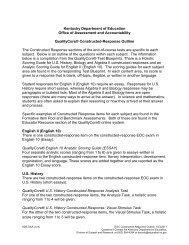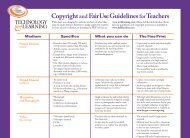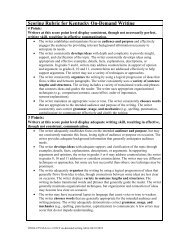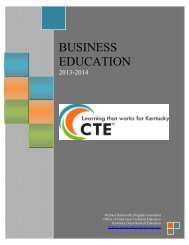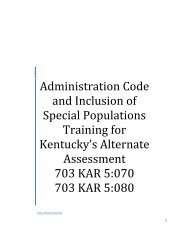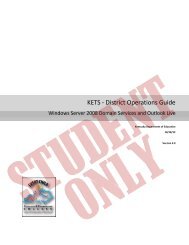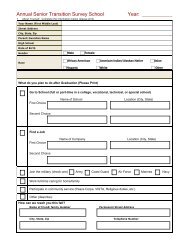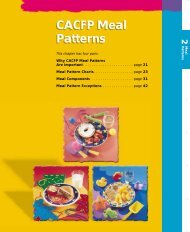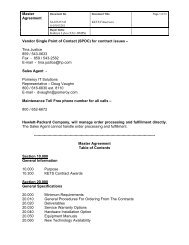Standards with Progressions grades K-HS v. 1.3 - Kentucky ...
Standards with Progressions grades K-HS v. 1.3 - Kentucky ...
Standards with Progressions grades K-HS v. 1.3 - Kentucky ...
- No tags were found...
Create successful ePaper yourself
Turn your PDF publications into a flip-book with our unique Google optimized e-Paper software.
Domains Congruence Similarity, Right Triangles, and<br />
Trigonometry<br />
Clusters<br />
Mathematical<br />
Practices<br />
Experiment <strong>with</strong><br />
transformations in<br />
the plane<br />
Understand<br />
congruence in<br />
terms of rigid<br />
motions<br />
Prove geometric<br />
theorems<br />
Make geometric<br />
constructions<br />
1. Make sense of problems and<br />
persevere in solving them.<br />
2. Reason abstractly and<br />
quantitatively.<br />
<strong>HS</strong> Conceptual Category: Geometry<br />
Understand similarity in terms<br />
of similarity transformations<br />
Prove theorems involving<br />
similarity<br />
Define trigonometric ratios and<br />
solve problems involving right<br />
triangles<br />
Apply trigonometry to general<br />
triangles<br />
3. Construct viable arguments and<br />
critique the reasoning of others.<br />
4. Model <strong>with</strong> mathematics.<br />
Circles<br />
Understand and apply<br />
theorems about circles<br />
Find arc lengths and<br />
areas of sectors of<br />
circles<br />
Expressing Geometric<br />
Properties <strong>with</strong> Equations<br />
Translate between the<br />
geometric description and<br />
the equation for a conic<br />
section<br />
Use coordinates to prove<br />
simple geometric<br />
theorems algebraically<br />
5. Use appropriate tools strategically.<br />
6. Attend to precision.<br />
Geometric Measurement<br />
and Dimension<br />
Explain volume<br />
formulas and use them<br />
to solve problems<br />
Visualize relationships<br />
between two<br />
dimensional and threedimensional<br />
objects<br />
Modeling <strong>with</strong><br />
Geometry<br />
Apply<br />
geometric<br />
concepts in<br />
modeling<br />
situations<br />
7. Look for and make use of structure.<br />
8. Look for and express regularity in<br />
repeated reasoning.<br />
An understanding of the attributes and relationships of geometric objects can be applied in diverse contexts—interpreting a schematic drawing, estimating the amount of wood<br />
needed to frame a sloping roof, rendering computer graphics, or designing a sewing pattern for the most efficient use of material. Although there are many types of geometry, school<br />
mathematics is devoted primarily to plane Euclidean geometry, studied both synthetically (<strong>with</strong>out coordinates) and analytically (<strong>with</strong> coordinates). Euclidean geometry is<br />
characterized most importantly by the Parallel Postulate, that through a point not on a given line there is exactly one parallel line. (Spherical geometry, in contrast, has no parallel<br />
lines.) During high school, students begin to formalize their geometry experiences from elementary and middle school, using more precise definitions and developing careful proofs.<br />
Later in college some students develop Euclidean and other geometries carefully from a small set of axioms. The concepts of congruence, similarity, and symmetry can be<br />
understood from the perspective of geometric transformation. Fundamental are the rigid motions: translations, rotations, reflections, and combinations of these, all of which are here<br />
assumed to preserve distance and angles (and therefore shapes generally). Reflections and rotations each explain a particular type of symmetry, and the symmetries of an object<br />
offer insight into its attributes—as when the reflective symmetry of an isosceles triangle assures that its base angles are congruent. In the approach taken here, two geometric figures<br />
are defined to be congruent if there is a sequence of rigid motions that carries one onto the other. This is the principle of superposition. For triangles, congruence means the equality<br />
of all corresponding pairs of sides and all corresponding pairs of angles. During the middle <strong>grades</strong>, through experiences drawing triangles from given conditions, students notice<br />
ways to specify enough measures in a triangle to ensure that all triangles drawn <strong>with</strong> those measures are congruent. Once these triangle congruence criteria (ASA, SAS, and SSS)<br />
are established using rigid motions, they can be used to prove theorems about triangles, quadrilaterals, and other geometric figures. Similarity transformations (rigid motions<br />
followed by dilations) define similarity in the same way that rigid motions define congruence, thereby formalizing the similarity ideas of "same shape" and "scale factor" developed<br />
in the middle <strong>grades</strong>. These transformations lead to the criterion for triangle similarity that two pairs of corresponding angles are congruent. The definitions of sine, cosine, and<br />
tangent for acute angles are founded on right triangles and similarity, and, <strong>with</strong> the Pythagorean Theorem, are fundamental in many real-world and theoretical situations. The<br />
Pythagorean Theorem is generalized to nonright triangles by the Law of Cosines. Together, the Laws of Sines and Cosines embody the triangle congruence criteria for the cases<br />
where three pieces of information suffice to completely solve a triangle. Furthermore, these laws yield two possible solutions in the ambiguous case, illustrating that Side-Side-<br />
Angle is not a congruence criterion. Analytic geometry connects algebra and geometry, resulting in powerful methods of analysis and problem solving. Just as the number line<br />
associates numbers <strong>with</strong> locations in one dimension, a pair of perpendicular axes associates pairs of numbers <strong>with</strong> locations in two dimensions. This correspondence between<br />
numerical coordinates and geometric points allows methods from algebra to be applied to geometry and vice versa. The solution set of an equation becomes a geometric curve,<br />
making visualization a tool for doing and understanding algebra. Geometric shapes can be described by equations, making algebraic manipulation into a tool for geometric<br />
understanding, modeling, and proof. Geometric transformations of the graphs of equations correspond to algebraic changes in their equations. Dynamic geometry environments<br />
provide students <strong>with</strong> experimental and modeling tools that allow them to investigate geometric phenomena in much the same way as computer algebra systems allow them to<br />
experiment <strong>with</strong> algebraic phenomena.<br />
Connections to Equations. The correspondence between numerical coordinates and geometric points allows methods from algebra to be applied to geometry and vice versa. The<br />
solution set of an equation becomes a geometric curve, making visualization a tool for doing and understanding algebra. Geometric shapes can be described by equations, making<br />
algebraic manipulation into a tool for geometric understanding, modeling, and proof.<br />
<strong>Kentucky</strong> Department of Education<br />
61 | P a g e




